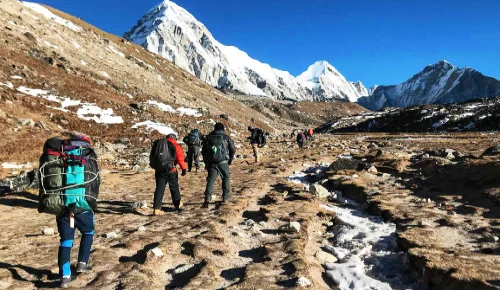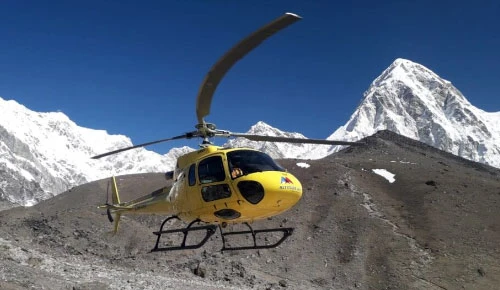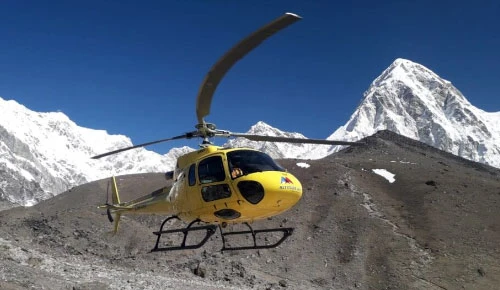Most Fascinating Wildlife and Birds on Kanchenjunga Circuit Trek
People from all over the world want to do trekking in Nepal. Nepal has long been known as a mountain lover's dream, starting with the famous treks in the Everest, Langtang, and Annapurna regions. These famous treks offer beautiful Himalayan scenery, lively cultures, and well-established facilities for trekking.
But for others who enjoy a more remote and tougher trekking experience, there is more in the Kanchenjunga region. Located in the far northeastern tip of Nepal, bordering Sikkim and Tibet, the region is home to Mount Kanchenjunga, the world's third-tallest mountain (8,586 meters). Unlike the more crowded routes, Kanchenjunga treks are lonely, with pristine nature and access to one of the most biologically diverse protected areas in the Himalayas—the Kanchenjunga Conservation Area.

There are several trek packages in this region, such as the Kanchenjunga Base Camp Trek and the Kanchenjunga CIrcuit Trek. Likewise, customized packages that connect remote villages and alpine landscapes. Trekkers pass through lush forests, high mountain passes, and sacred valleys that are home to exclusive Himalayan flora and fauna.
In this blog, we're putting the spotlight on the 6 most fascinating animals and birds you may encounter on your Kanchenjunga Circuit Trek. From the elusive red panda to the flamboyant Himalayan monal, this trek is a wildlife wonderland no less than a scenic one. Let's discover Kanchenjunga's natural wonders!
Wildlife & Bird Diversity in the Kanchenjunga Region
The Kanchenjunga region of Nepal is a stunning biodiversity hotspot within the Kanchenjunga Conservation Area—a protected reserve spanning over 2,035 square kilometers of pristine wilderness. The rugged and inaccessible landscape supports an incredible range of flora and fauna, owing to its immense altitude range, from subtropical forests at lower elevations to alpine meadows and snow-capped peaks over 8,000 meters.

The rich habitats harbor many endangered and rare species, a wildlife and bird watcher's paradise. Its residents are shy mammals like the endangered red panda and the elusive snow leopard, both symbols of the fragile Himalayan ecosystem. The region also boasts an impressive array of birdlife, ranging from Nepal's national bird, the Himalayan monal, to colorful pheasants and high-altitude species like the blood pheasant and satyr tragopan.
The commitment of the Kanchenjunga Conservation Area to preserving these habitats protects wildlife and ensures the ecological balance necessary for the local communities who live nearby and depend on the land. Trekking here offers a unique chance to experience the beauty and variety of Himalayan wildlife in one of Nepal's least disturbed natural environments.
Table of Contents
Wildlife You Might Spot on the Trekking Trail
The Kanchenjunga Circuit Trek not only has stunning views of the mountains, but it also gives you a chance to see a wide range of animals in their natural habitats. As you go through thick forests, alpine meadows, and lonely valleys, look for some of the most fascinating creatures and birds in the area. The track is full of amazing animals, from uncommon mammals to colorful birds, that make your hike even more special.
On the Kanchenjunga trek, you may see these six amazing animals:
Snow Leopard

Revered as the "ghost of the Himalayas," the snow leopard is a master of camouflage and rarely seen by humans. These elusive predators inhabit the rugged alpine terrain above 3,500 meters, silently roaming the ridges near Lhonak and Pangpema. While direct sightings are rare, trekkers sometimes come across fresh paw prints in the snow or claw marks on boulders—an eerie but exciting reminder of their presence.
Red Panda

With its reddish-brown fur, masked face, and bushy tail, the red panda is a highlight of the Kanchenjunga wildlife experience. These tree-dwelling, bamboo-loving mammals are most active at dawn and dusk and are often found between 2,200 and 3,500 meters in the dense bamboo forests near Gyabla and Amjilosa. As a globally endangered species, catching a glimpse of one in the wild is a rare and magical moment.
Himalayan Black Bear

These reclusive giants are typically found between 2,000 and 3,800 meters in temperate forests. Characterized by their black fur and distinctive white chest patch, Himalayan black bears are most active in spring and summer when they forage for roots, berries, and insects. Trekkers may spot signs of their activity—scratched tree trunks, claw marks, or even fresh scat—though the animals themselves usually avoid human contact.
Blue Sheep & Himalayan Tahr

Blue sheep, or bharal, blend perfectly with the rocky cliffs they call home. Their blue-grey coats provide natural camouflage, making them challenging to spot. They often travel in herds, especially near Sele Le and Pangpema.

Alongside them, the Himalayan tahr—a goat-like herbivore with a thick, reddish mane—is frequently seen on steep slopes, effortlessly navigating cliffs that would seem impossible to humans.
Musk Deer & Himalayan Goral

Musk deer are shy, nocturnal creatures with fang-like tusks and scent glands prized for traditional medicine. They prefer dense undergrowth in forested areas and are mostly seen at dawn or dusk.

The Himalayan goral, a nimble antelope-like mammal, thrives on steep, rocky terrain. Their agility and sure-footedness often allow them to escape detection unless you’re trekking quietly and patiently.
Himalayan Wolf

A rare predator of the high Himalayas, the Himalayan wolf differs genetically from its lowland cousins and is adapted to life above 4,000 meters. Leaner and longer-legged, these wolves have a keen sense of smell and tend to avoid humans. Though sightings are scarce, evidence such as scat, tracks, or distant howls may be picked up in the windswept valleys during early morning treks.
Birds You Might Spot on the Trekking Trail
As you hike over the rough trails of the Kanchenjunga region, the skies and forests come to life with a colorful group of birds. This less-traveled Himalayan corridor is home to some of Nepal's most beautiful birds, each of which adds a burst of color and melody to your walk. These birds give hikers amazing moments that connect them closely with nature's rhythm, whether they're dashing through thick rhododendron forests or soaring over alpine meadows.
You might see these six amazing birds on your trip:
Himalayan Monal (Danphe)

A true jewel of the Himalayas, the Himalayan Monal is Nepal’s national bird and one of the most photographed species in the region. Males boast shimmering feathers in metallic hues of blue, green, and gold, while females wear more subdued tones. They forage in alpine meadows between 3,000 and 4,500 meters, especially near Sele Le and Sinion La passes. If you're trekking early in the morning, listen for their whistling calls.
Satyr Tragopan

A real showstopper in the bird world, the Satyr Tragopan is a rare and striking pheasant with crimson feathers and intricate spotted patterns. Males display brilliant blue facial wattles during the breeding season, making them look like something out of a fantasy novel. These birds thrive in rhododendron forests between 2,500 and 4,000 meters and are best spotted in spring.
Blood Pheasant

Despite its dramatic name, the blood pheasant is a gentle, ground-dwelling bird found in alpine thickets and scrublands. It gets its name from the red splash-like coloring on its breast and face. Often seen in small groups, they forage quietly in high-altitude zones and are quite camera-friendly if approached respectfully.
Tibetan Snowcock & Himalayan Snowcock

These hardy, high-altitude dwellers are often seen foraging in scree-covered slopes or open meadows at 4,000 meters and above. Their loud, whistling calls echo across the valleys at dawn. If you're trekking in the early morning, you're more likely to spot them in flocks moving like sentinels across barren slopes.
Griffon Vulture

Look to the skies, and you'll often see massive raptors soaring with elegance and power. The Himalayan Griffon Vulture—one of the world’s largest birds—circles high above, scanning for carrion. Bearded Vultures (Lammergeiers) are known to drop bones from great heights to crack them open for marrow. Golden eagles, swift and regal, add a predatory thrill to the skies.
Passerines & Woodpeckers

The forested lower sections of the trek are full of birdsong from smaller, often overlooked species. Warblers flit through the underbrush, drongos dart like acrobats between branches, and colorful finches add bursts of color to the greenery. Keep an eye out for Nepal’s endemic species and vibrant woodpeckers drumming against the tree trunks.
Best Time for Wildlife & Bird Watching
The best times for wildlife and bird watching on the Kanchenjunga Circuit Trek are spring (March to May) and autumn (September to November). In spring, as the snow melts and forests burst into vibrant bloom, animals like the red panda and Himalayan black bear become more active, descending to lower elevations in search of food. Birdwatchers can enjoy the spectacle of colorful mating plumage and melodious courtship calls resonating through rhododendron forests.
Autumn, on the other hand, offers post-monsoon clarity with crisp skies and excellent visibility, making it ideal for spotting wildlife across open valleys and ridgelines. This season is especially rewarding for observing high-altitude birds and tracking mammals near alpine zones such as Pangpema and Lhonak. Additionally, seasonal migrations bring rare bird species to the region, adding to the richness of the Kanchenjunga wildlife experience..
Tips for Spotting Wildlife
- Start your trek early in the morning.
- Walk quietly and avoid sudden movements to prevent scaring animals away.
- Start your trek early in the morning when wildlife is most active.
- Use binoculars to scan treetops, ridges, and forest clearings from a distance.
- Wear earthy or neutral-colored clothing to blend in with the natural environment.
- Be patient and take frequent pauses to observe your surroundings carefully.
- Avoid using strong scents like perfumes or deodorants that may alert animals.
- Listen for rustling leaves, calls, or movement rather than just relying on sight.
- Stay with a local guide who knows common animal paths and sighting spots.
What Makes Kanchenjunga a Paradise for Animal & Bird Enthusiasts?
Kanchenjunga's remote terrain and very high biodiversity position it as a perfect holiday destination for wildlife lovers to enjoy rare animal sightings in a peaceful Himalayan setting.
- The trails are tranquil and less crowded, offering greater chances to witness animals undisturbed.
- Different ecosystems support varied fauna, from lowland woodland to high alpine habitat.
- The region falls under the jurisdiction of the Kanchenjunga Conservation Area, further promoting wildlife conservation.
- Trekkers have the chance to spot the elusive red panda and snow leopard in their natural habitats.
- Untouched and pristine wilderness offers an authentic and unprocessed experience with nature.
- Birdwatchers have the chance to spot colorful Himalayan birds at different altitudes.
- Local guides enhance the probability of sightings because of their intimate knowledge of animal behavior.
Conclusion
The Kanchenjunga Trekking offers more than just towering peaks and ancient villages. It's an invitation into a vibrant ecosystem teeming with rare birds, majestic beasts, and untouched beauty. Whether you're a seasoned trekker or a nature enthusiast, this journey will fill your lens and your heart.
Book your Kanchenjunga adventure today with Nepal Trek Adventures and get closer to the wild side of Nepal!








